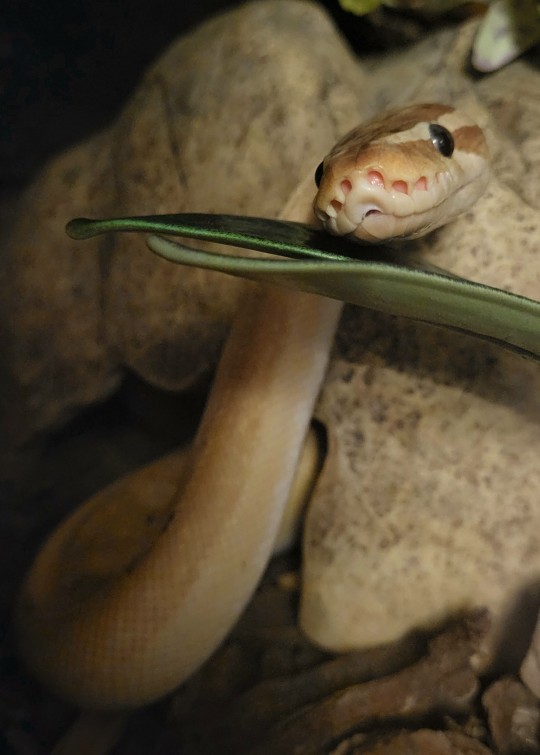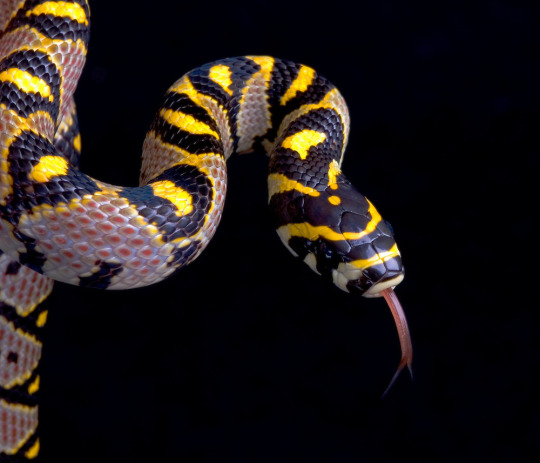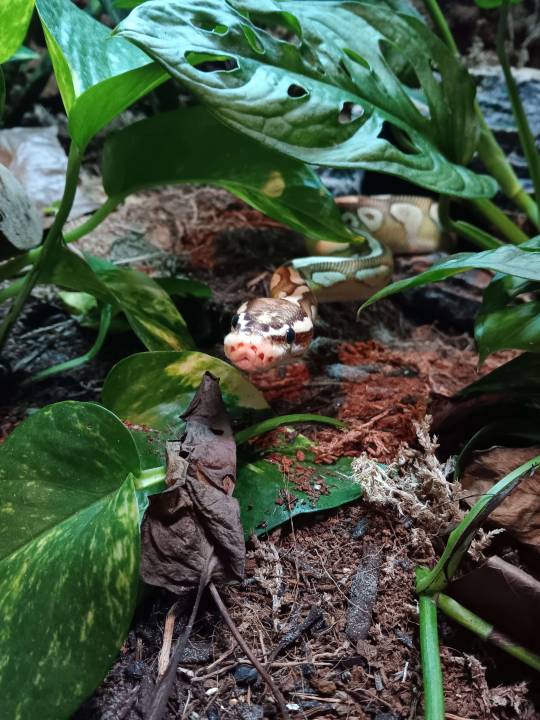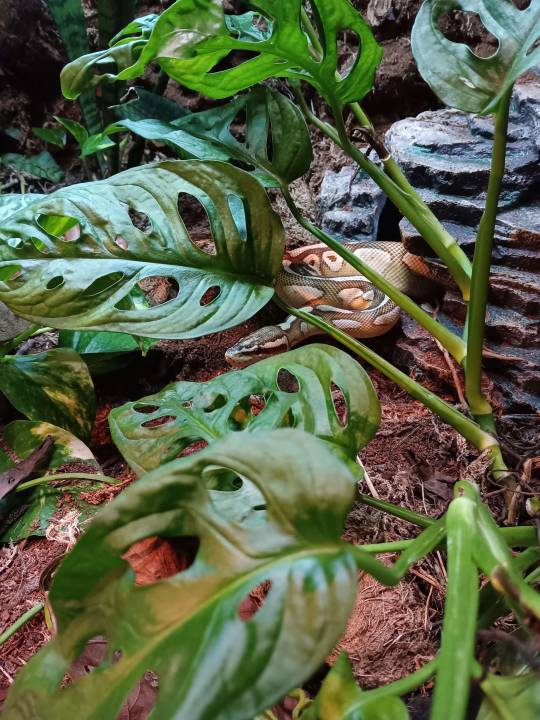Photo
Hi I barely post!
Heres some fun facts for you:
I believe this is a Cuban Crocodile. Cuban Crocodiles are known for their Galloping and their ability to *leap* pretty well, actually! These guys can full send it on land. They don't typically get as *big* as the other Crocodilian species, but theyre still a force to be respected!
Unfortunately; these beautiful animals aren't doing well in their natural environment. Do to our severe lack of understanding and extreme judgement, this animal, like many, Has been over-hunted and nearly destroyed. Which is unfortunate; because this species of crocodile isn't known for its attacks on people unless provoked.
I could get into it about the history of this species because its very interesting and very tragic- tale as old as time. But I implore you to do your own research about them; Its always good to make an active effort to better understand endangered species and always good to have more people looking into species that are in need of our help.

graceful gallop
84K notes
·
View notes
Text



Ive shown off two of my more common species, so why don't I give something special shine?
This is my juvie female Dominican Red Mountain Boa, who will be one in the month of October. <3 She's just starting to get her coloration, and I'm extremely excited to see how she grows.
2 notes
·
View notes
Text


While I'm working on my Honduran Milks bioactive, I did wanna take the time to talk about Links Bioactive. Link is my overweight[He's working on it! <3] Male Emergency re-home Ball Python. I typically avoid this species, but he's been a fantastic little Unicorn for me.
So lets talk about Link's enclosure and how it works!
Link is in a 4ft x 2ft x 2ft PVC Enclosure- this is the *minimum* size this species requires to thrive.
His substrate is made up of a layer of perlite sitting at the bottom of his enclosure, this layer of perlite acts as a drainage layer. This drainage layer, which catches excess water that seeps through the substrate. It also helps with catching potentially bad bacteria, and helps with your plants roots!
The rest of the substrate sitting ontop of that layer of perlite is a mix of Ecogro organic topsoil, Coco fiber, and Sphagnum moss. I cannot stress this enough, but if you choose to do a bio-active enclosure PLEASE be sure to choose a organic substrate!! Fertilized substrate can be toxic to your animal, this includes manure-based fertilizers.
To promote healthy growth, I choose to use Coco fiber and Sphagnum Moss. The Coco fibe[Coco peat] Is a safer way to promote healthy soil for both your plant, and your animals, while the Sphagnum Moss is fantastic at holding water and Nutrients for your plants.
The arguably biggest and most important part of this enclosure is the cleanup crew. Your cleanup crew will break down decaying plant matter and your animals feces and return it to the soil, as well as cleaning bacteria growth. Bio-actives cannot function in the long-run without a cleanup crew.
The cleanup crew I chose consist of Dairy Cow isopods[Porcellio laevis], and Temperate Springtails[Collembola sp.]. You can Mix-and match your Isopods and Springtails as long as its a species that can tolerate the humidity and temps your animal requires, HOWEVER! Its important to note your Isopod species. I chose not to mix Isopods in this enclosure as Dairy cows are kinda known for being aggressive.
For plants, ball Pythons are incredibly Bulldozery animals and will trample much of your flora. Needing hardy plants that could survive being trampled and occasionally uprooted was a must for him, and after thought and research, I ended up settling on these:
Golden Pothos, Snake plants, and Jade Pothos. Some just overall incredibly hardy plants that, since having them, I've found fantastic success with surviving Links night-time pathing and assaults.
I also have a Philodendron [Monstera adansonii,] in there, providing cover and clutter around and over his hot hide. I'm proud of this plant surviving so far, to say I added it with a specific reason would be a goddamn lie lmao I just loved how cool it looked. The fact it's survived and adapted for as long as it has is a miracle in of itself, and I wish great health amongst this trooper of a plant.
I deep water once a week to keep my plants healthy and the soil moist enough for my isopods to thrive, with occasional spraying staggered through the week.
Overall, this is how Links Bioactive tank is settup! Is this the only way to set up a Bioactive tank? Certainly not! There's plenty of ways you can setup a Bioactive. Does your animal absolutely NEED a bioactive enclosure? For a lot of animals that answers going to be no! It doesn't.
Bio-active vs Non-bio-actives have their pros and cons that, maybe Ill ramble about in a later post. And probably talk on what a Bioactive even is and go into much more detail than I did here about how it works. But I chose Bioactive personally because the long-term upkeep is less costly and labor-inducing, and I just love the looks of them. AndICanHaveAsManyGoddamnIsopodsAsIWant<3
#bioactive#vivarium#info dump#biology#ball python#reptile#isopods#plants#I got lazy towards the end and just started saying Bioactive#herpetology#snake#botony#horticulture
56 notes
·
View notes
Text

His little pink heat pits are so cute wtf
[id: Banoffee, the yellow and white ball python with black freckles, curled up resting his head on a green plant in his enclosure]
189 notes
·
View notes
Text

Mandarin Rat Snake (Euprepiophis mandarinus), family Colubridae, found in East Asia
photograph by Michael D. Kern
www.thegardensofeden.org
294 notes
·
View notes
Text


Lampropeltis triangulum hondurensis, also commonly known as a Honduran Milk snake. Wild-type adult presumably female.
We're working on making her a bio-active tank, this species has a fantastic range of tolerance, giving us room to work with a lot of different concepts and potential tankmates. Will update as we go to show how we set these bio-actives up.
#milk snake#snake#reptiles#bioactive#The hardest part of this honestly?#Picking what Reptile safe flowers I want to use#This one is going to be a bright and pretty one Ideally#We have a potential theme going#Second hardest part is choosing what adorable isopods I want#There is SO many choices and I already have Cows
5 notes
·
View notes
Text



I absolutely adore his inquisitive personality, he comes to investigate every watering. Next Goal? Get a good Yawn photo.
Link/Apollo, Morhped[Lesser] Ball Python. Featured plants are Philodendron [Monstera adansonii,], Golden Pothos, Jade Pothos.
*Disclaimer ramble:
Pothos plants are incredibly hardy and are very good for bull-dozery species such as Ball Pythons. However, these are NOT safe plants for herbivorous animals or animals that may chew on them- Pothos are inherently toxic so be careful with what animals you pair them with.
#snake#ball python#vivarium#terrarium#bioactive#reptile#plants#Seriously though#Don't use Pothos with like#the majority of lizards#Theres plenty of other options that arent toxic and can cause them harm
3 notes
·
View notes